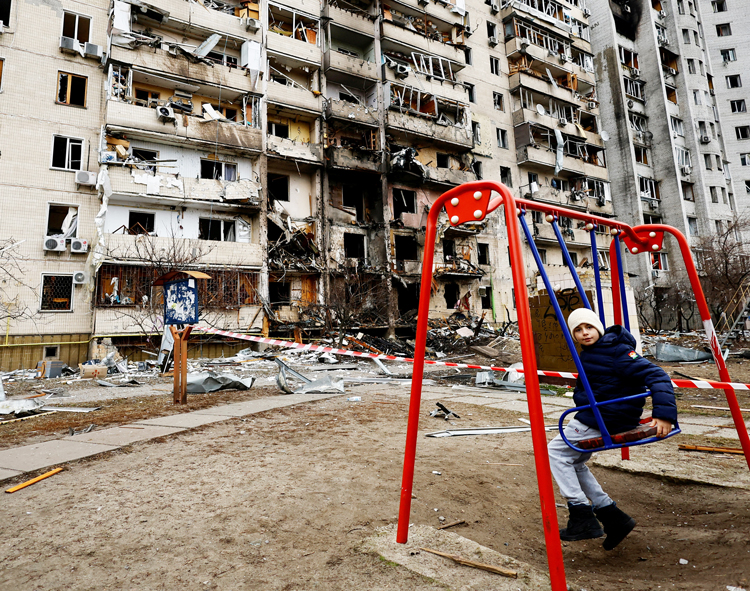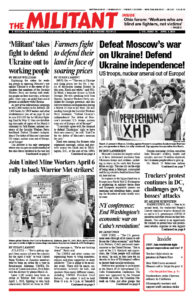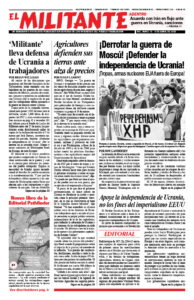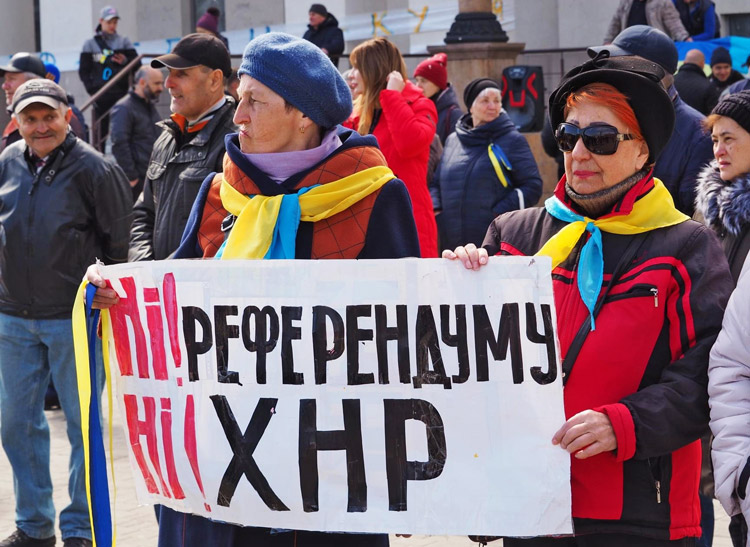Moscow’s invasion has largely stalled as it faces determined resistance from Ukrainian troops and civilians, including in towns in the south that Russian forces occupy. The one city on the edge of being taken is Mariupol, surrounded and facing relentless bombardment from air, land and sea.
In response to the biggest land war in Europe since World War II, Washington is reinforcing its military forces there and European imperialist powers are rearming and rebuilding theirs, sounding the drumbeat of more deadly wars to come.
Despite mounting civilian casualties from Moscow’s artillery, bombs and missiles, and over 10 million displaced, the Ukrainian people refuse to give up.
On March 19 Belarusian railway workers set an example of international working-class solidarity by disrupting the Russian supply network. They sabotaged the train line leading into Ukraine that is used by Moscow to transport troops, fuel, food and other reserves.
Belarusian dictator Alexander Lukashenko, who had to rely on Moscow to ride out mass protests in 2020, has so far been unable to meet Russian President Vladimir Putin’s pressure to contribute troops, fearing this would deepen opposition to his regime at home.

Weeks of shelling have trapped over 100,000 civilians in Mariupol, a key southern port city. Much of the city has been reduced to rubble. Ukrainian fighters refuse to surrender. A maternity hospital there was flattened, as were a theater and an art school, burying hundreds of people alive. A particular target of Moscow’s offensive has been to try and take the city’s two huge steel plants.
“We will never return there if Russia takes it, but we are prepared to live in the ruins if it remains Ukrainian,” Mariupol resident Natalia Poluiko told the press after fleeing the carnage.
In Kherson, angry Ukrainian civilians forced two Russian military trucks to back out of the town square. The next day protesting residents were attacked by Russian soldiers. Several were injured and others detained, but protesters kept returning carrying Ukrainian flags.
Foreseeing a future of growing instability and more wars, Washington is taking steps to prepare to defend its imperialist interests. In the wake of Moscow’s invasion, the U.S. government is reversing a decadeslong decline of U.S. troop numbers in Europe. It has boosted its forces there to over 100,000, the highest level since 2005.
They are spread across 19 countries, including former Warsaw Pact states now in the NATO alliance. Some U.S. troops have been sent to Poland, near the Ukrainian border. The Pentagon has also sent F-35 fighter planes and Apache helicopters to Poland and Hungary.
Drumbeat of wars to come
As the U.S. rulers’ intervention in Europe increases and calls for Washington to enforce “no-fly” zones continue, it’s worth recalling the horrific consequences of previous U.S. wars on the continent. This includes the bombing and dismemberment of Yugoslavia in the 1990s. There, a no-fly zone became a step to a deeper war.
During the second imperialist world war, Washington and London carpet bombed Hamburg and Dresden, industrial German cities, suffocating or incinerating tens of thousands in the ensuing firestorms. Washington built its supremacy in Europe on that carnage.
Over a third of U.S. troops in Europe are based in Germany. In response to the Ukraine war, the rulers in Germany have launched their own sizable rearmament program. This is their first substantial military expansion since the end of the Cold War. The German rulers are moving to reduce their overwhelming reliance on gas imports from Russia. Berlin has turned to Qatar for liquefied natural gas imports.
All the European imperialist powers, as well as China and Russia, are seeking allies and sources of needed imports as the war deeply shakes the “world order” of the past. And capitalist rulers across the semicolonial world — from India to the Middle East — reassess where their interests can best be protected.
At a March 5 TV conference in Kyiv, Russian troops who had surrendered spoke out against the war, calling on the Russian people to “take to the streets” to demand a halt to Moscow’s invasion.
“Here everything is not like they say on Russian television,” said Dmitry Gagarin, one of the soldiers.
“The Ukrainian people are not afraid of anyone,” Mikhail Kulikov said. “They will stand up for their land to the last.”
There are numerous online videos and reports of Russian troops refusing to attack civilians. Others have slashed gas lines on their tanks to avoid combat.
The Putin regime has moved to suppress widespread anti-war demonstrations at home. Putin says Russia now needs a “self-purification” in order to distinguish “true patriots from scum and traitors.”
The road forward for working people in the fight to defeat Moscow’s trampling on Ukrainian independence lies in winning workers and farmers in Russia and worldwide to join their comrades in Ukraine in shared action against the war. Working people have no common interests with “our” capitalist governments, and must rely on our own strength to defend our interests.
Sanctions by Washington and capitalist powers in Europe are a deadly obstacle to this course. They have pounded the Russian economy, isolating its banking system internationally and blocked many imports. Factories and retail chains have closed, causing heavy job losses. Shortages are rife. Workers there face soaring prices.
Saying Russians will face more hardships, Putin urges them to rely on his thug regime for protection from U.S. sanctions as he tries to rally support for the war. He promised to increase all social payments and the minimum wage, offering “state support” for those who lost their jobs.
There are numerous examples of fraternization and collaboration across borders against Putin’s war. A group of world renowned ballet dancers from Russia and Ukraine, Argentina, Cuba, France and Japan came together for a benefit performance for Ukraine at the London Coliseum March 20. In contrast to bans on Russian artists elsewhere, the music included Russian composers like Tchaikovsky and Rachmaninoff.
Ukrainian dancer and producer Ivan Putrov made a key point: “Russian culture doesn’t have anything to do with Putin, and equally Putin has nothing to do with Russian culture.”
Cuba’s Javier Torres of the Northern Ballet performed “The Death of a Swan.” He compared it to Ukrainians resisting Moscow’s invasion and to the Cuban people who have successfully resisted decades of a U.S. economic war aimed at overturning their socialist revolution.


